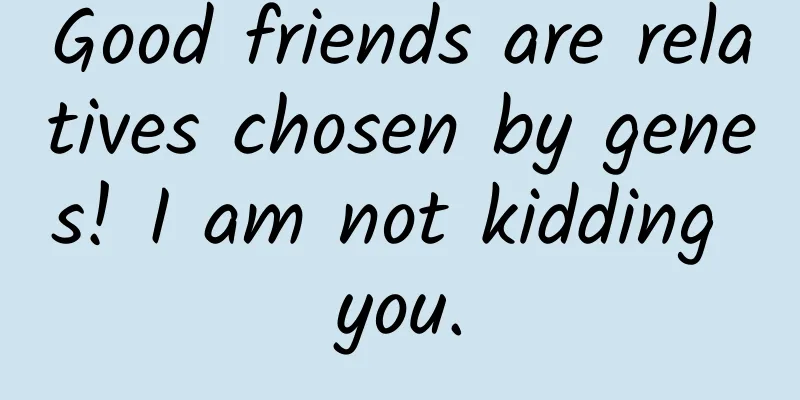Good friends are relatives chosen by genes! I am not kidding you.

|
Do you have such a person around you, with whom you can share your happiness or sadness. You have endless common topics to talk about, similar tastes, and matching behavior patterns. You are close friends and half-brothers/sisters. What made you find each other in such a vast sea of people? Was it fate, mathematical probability, or destiny? A scientific study suggests that genes may have played a role in this. Copyright images in the gallery. Reprinting and using them may lead to copyright disputes. Friends, we are really relatives without blood relationship In 2014, in a paper published in the Proceedings of the National Academy of Sciences, researchers from Harvard University and the University of California, San Diego came to an interesting conclusion through data analysis: the kinship coefficient between friends is 0.0014 higher than that between strangers! How did this data come from? The researchers first retrieved the genetic information of 1,932 volunteers from the database and divided them into 1,367 pairs of non-relative friends and 1,196,429 pairs of strangers. Next, they compared the kinship coefficients of the friend group and the stranger group, which required the use of SNPs in genetics to calculate. SNP refers to the mutation of a single nucleotide (A, T, C, G) in the genome. For example, if Zhang San has adenine (A) and Li Si has thymine (T) at a certain position, then this site is a SNP that can be used to distinguish Zhang San from Li Si. Extended to the population, the more common SNPs two people have, the more similar their genes are, and the higher the probability that they are derived from the same ancestor. The researchers found that the kinship coefficient between friends was significantly higher than that between strangers, while that between friends with opposite SNPs was significantly lower than that between strangers. On average, the kinship coefficient of friends was 0.0014 higher than that of strangers. Figure 1: Friends have significantly more identical SNPs than strangers, and significantly fewer opposite SNPs than strangers. | Image source: Reference [14] Don't underestimate this number. You should know that the affinity coefficient between parents and children is about 0.25, the affinity coefficient of first cousins (such as cousins) is about 0.0625, and the affinity coefficient of fourth cousins (cousins who share a great-great grandfather) is about 0.001. In other words, the genetic similarity between you and your best friend is even higher than that of the grandchildren of your uncle who stands next to you during ancestor worship! So, saying to a good friend, "You are my non-blood relative" is not sensationalism, but science. It was the olfactory gene that brought us together So why are people with high levels of genetic relatedness more likely to become friends? Some theories suggest that this may be related to the sense of smell. For example, in a 2014 study, researchers found that similar SNPs between friends were not evenly distributed in the genome, but showed an obvious pattern: among the 174 genes ranked in the top 1% of similarity, most were related to the sense of smell. In other words, close friends are likely to have the same sense of smell. Researchers say that smell helps humans (and other primates) recognize kin, and there is even some evidence that people can tell friends from strangers based on blind sniff tests. Individuals with the same sense of smell may be drawn to similar environments, where they can interact and bond with each other. In addition, in 2022, a study published in Science Advances by the Weizmann Institute of Science in Israel proved that people with similar body odor are more likely to become friends. The researchers recruited 20 pairs of friends who were called "Instant Friends". These people did not know each other since childhood, but established a deep friendship in a short period of time. The participants collected sweat samples in a strictly controlled environment: They were asked to eat and drink the same food (avoid foods that affect body odor, such as garlic, coffee, etc.). Use the same unscented soap and toiletries. Wear the provided cotton T-shirt when sleeping so that the clothing absorbs sweat. Then, an electronic nose (eNose) was used to analyze the chemical composition of body odor and calculate the similarity of body odor. At the same time, volunteers were asked to smell the odors of the 20 pairs of friends and the interference odors and score them. The results showed that both electronic noses and human noses can think that the odors between good friends are more similar. Subsequently, the researchers recruited 17 volunteers who did not know each other and asked them to pair up and stand face to face at a very close distance (to ensure that they could smell each other), then play a mirror game but could not talk, and finally asked them to evaluate whether they liked each other. By comparing the body odors of the volunteers with an electronic nose, it was found that strangers with higher body odor similarity were more likely to establish a good relationship during interaction: they felt close more quickly when they first met, their body language during interaction was more relaxed (such as smiling, leaning closer to each other), and they had a better impression of each other after the interaction. Strangers playing a mirror game | Image source: Reference [15] Some studies suggest that choosing friends with similar body odor may be related to MHC genes. Body odor is associated with MHC (Major Histocompatibility Complex) genes, which encode leukocyte antigens that help the immune system recognize which cells are self and which are foreign invaders. The MHC between relatives is more similar, so when choosing a mate, women are more inclined to choose the body odor of men with different MHC genes from their own based on body odor to prevent inbreeding. The similar body odor between friends may reflect a " kin recognition " mechanism, that is, we subconsciously choose people who are closer to the family odor as social objects . This may be because in early human society, odor may be a key clue to identify tribal members, and people with similar body odor are more likely to trust each other, thus forming a closer cooperative relationship and improving their chances of survival. In addition, people with similar body odor may have similar immune systems and adapt to similar environments, which improves the adaptability and cooperation of the group. Next time you meet up with a good friend, why not smell his or her scent while hugging her or her, and then compare it with your own! Easter Egg: Fun Test **Select the similarities between you and your friends to generate a genetic similarity report - **Similar things attract each other. Friends often have a lot in common. Some of them may seem to be just personal preferences, but genes actually play a role behind them. The following 3 options all mean that you and your best friend may have common genes. Take them to test what your common genes are: 1 Always send each other "Are you asleep?jpg" late at night If this is always the case for you, then congratulations, you are a night owl - staying up late is in your genes. People who go to bed late may carry the CRY1 gene mutation, which is related to human delayed sleep phase syndrome (commonly known as "night owls"). People who carry this gene mutation have a sleep phase that is 2 to 2.5 hours later than normal people. Copyright images in the gallery. Reprinting and using them may lead to copyright disputes. 2 I am always criticized for being picky about food: I don’t eat cilantro; I don’t eat bitter melon; I think pork smells bad. If you are always like this, then congratulations, you are a group of foodies - your genes determine that you are "eating partners". People who don't like cilantro may carry a mutation in an olfactory receptor gene called OR6A2. This gene is located on chromosome 11 and encodes a receptor that is highly sensitive to aldehyde compounds such as E-2-decenal. These aldehydes give cilantro its characteristic smell, but in some people they are perceived as smelling like soap or bugs, leading to an aversion to cilantro. People who are sensitive to bitter taste may carry a mutation in the TAS2R38 gene, which is located on chromosome 7 and encodes a human bitter taste receptor that is primarily responsible for sensing bitter substances such as phenylthiourea (PTC) and 6-propyl-2-thiouracil (PROP). People with this gene mutation are very sensitive to bitter taste. People who think pork smells fishy may carry two copies of the OR7D4 gene, which makes people sensitive to the smell of androstenone in pork. People who carry OR7D4 gene mutants (such as R88W and T133M mutations) may not be able to smell pork. 3 Love to play escape room, love adventure If you are always like this, then congratulations, you are a mirror image of your personality - your adventurous gene has found its kind. People who like novelty and risk taking may carry a mutation in the DRD4 gene (such as the 7-repeat allele, called DRD4-7R), which is located on human chromosome 11 and encodes a dopamine receptor. It is important to note that although the variation in the DRD4 gene is associated with risky behavior, individual behavior is also influenced by multiple factors such as environment, education, and other genes. References [1]NA Christakis, & JH Fowler, Friendship and natural selection, Proc. Natl. Acad. Sci. USA 111 (supplement_3) 10796-10801, https://doi.org/10.1073/pnas.1400825111 (2014). [2]SB Olsson, J Barnard, L Turri, Olfaction and identification of unrelated individuals: Examination of the mysteries of human odor recognition. J Chem Ecol 32, 1635–1645 (2006). [3]M Boulet, MJE Charpentier, CM Drea, Decoding an olfactory mechanism of kin recognition and inbreeding avoidance in a primate. BMC Evol Biol 9, 281 (2009). [4]Ravreby I, Snitz K, Sobel N. There is chemistry in social chemistry[J]. Science Advances. 2022;8(25):eabn0154. [5]RH Porter, Olfaction and human kin recognition. Genetica 104, 259–263 (1998-1999). [6]Ruff JS, Nelson AC, Kubinak JL, Potts WK. MHC signaling during social communication. Adv Exp Med Biol. 2012;738:290-313. doi: 10.1007/978-1-4614-1680-7_17. PMID: 22399386; PMCID: PMC4835215. [7]Wedekind C, Seebeck T, Bettens F, Paepke AJ. MHC-dependent mate preferences in humans. Proc Biol Sci. 1995 Jun 22;260(1359):245-9. doi: 10.1098/rspb.1995.0087. PMID: 7630893. [8]Santos PS, Schinemann JA, Gabardo J, Bicalho Mda G. New evidence that the MHC influences odor perception in humans: a study with 58 Southern Brazilian students. Horm Behav. 2005 Apr;47(4):384-8. doi: 10.1016/j.yhbeh.2004.11.005. PMID: 15777804. [9]Patke A, Murphy PJ, Onat OE, Krieger AC, Özçelik T, Campbell SS, Young MW. Mutation of the Human Circadian Clock Gene CRY1 in Familial Delayed Sleep Phase Disorder. Cell. 2017 Apr 6;169(2):203-215.e13. doi: 10.1016/j.cell.2017.03.027. PMID: 28388406; PMCID: PMC5479574. [10]Eriksson, N., Wu, S., Do, CB et al. A genetic variant near olfactory receptor genes influences cilantro preference. Flavor 1, 22 (2012). https://doi.org/10.1186/2044-7248-1-22 [11]Khataan NH, Stewart L, Brenner DM, Cornelis MC, El-Sohemy A. TAS2R38 genotypes and phenylthiocarbamide bitter taste perception in a population of young adults. J Nutrigenet Nutrigenomics. 2009;2(4-5):251-6. doi: 10.1159/000297217. Epub 2010 May 19. PMID: 20484932. [12]Lunde K, Egelandsdal B, Skuterud E, Mainland JD, Lea T, Hersleth M, Matsunami H. Genetic variation of an odorant receptor OR7D4 and sensory perception of cooked meat containing androstenone. PLoS One. 2012;7(5):e35259. doi: 10.1371/journal.pone.0035259. Epub 2012 May 2. PMID: 22567099; PMCID: PMC3342276. [13]Wang E, Ding YC, Flodman P, Kidd JR, Kidd KK, Grady DL, Ryder OA, Spence MA, Swanson JM, Moyzis RK. The genetic architecture of selection at the human dopamine receptor D4 (DRD4) gene locus. Am J Hum Genet. 2004 May;74(5):931-44. doi: 10.1086/420854. Epub 2004 Apr 9. PMID: 15077199; PMCID: PMC1181986. [14]https://www.pnas.org/doi/10.1073/pnas.1400825111#fig01 [15]https://www.science.org/doi/10.1126/sciadv.abn0154 Planning and production Author: Hardy, PhD in Neurobiology, Zhejiang University Reviewer: Zhao Wei, Chief Physician, Department of Neurology, Tianjin University TEDA Hospital Planning丨Yinuo Editor: Yinuo Proofread by Xu Lai and Lin Lin The cover image and the images in this article are from the copyright library Reprinting may lead to copyright disputes |
<<: Is it the season for rashes again? Don’t worry, take a look at Feng Shui first
Recommend
No money will be deducted from the App Store purchases? That's wishful thinking, it just doesn't show up in real time
On November 21, the three-day Apple 1 yuan promot...
New Media Operations in My Eyes | Please Stop Calling Me a "Writer"
The slogan "Print media is dead" has be...
How much does it cost to make a car moving app in Zhangjiakou?
There is no fixed price for the production of Zha...
The most powerful copywriting for 520 Confession Day in history is here! !
520 is other people’s Valentine’s Day , but it is...
How can a tiny sheepgrass turn sand into green?
Leymus chinensis is a high-quality forage grass b...
Huaqing Embedded Development System Course_2021
: : : : : : : : : : : : : : : : : : : : : : : : : ...
Wearable devices may promote the integration of wireless technology
[[147161]] Although most of the current wearable ...
An article to understand the communication between Android and Flutter
As a cross-platform solution, Flutter is often em...
The Chinese version of Tesla, NIO ES8, is launched. Can consumers buy into its high-end positioning?
In the field of new energy vehicles in China, the...
Can earthquake clouds and animal perception predict earthquakes?
In fact, in life, we often hear rumors about eart...
Product analysis of soul, Tantan and Jimu social apps!
In 1943, Abraham Maslow proposed the famous Maslo...
Yan Jie's 36 Fat Burning and Fast Slimming Method: Sculpt your body and get a slim and graceful figure
Yan Jie's 36 Fat Burning and Fast Slimming Me...
Samsung monopolizes Snapdragon 835, LG G6 is forced to polish 821 processor
It has been rumored for a long time that Samsung ...
WeChat always takes up a lot of memory. Don't clean it up randomly. These four tips are the most practical.
The most painful thing is that WeChat records can...
Dali said: A compulsory course for live broadcast products: five courses analyzing the underlying operational logic of product selection, testing, ranking, and promotion in live broadcast rooms
Dali said that live broadcast products are a must...









